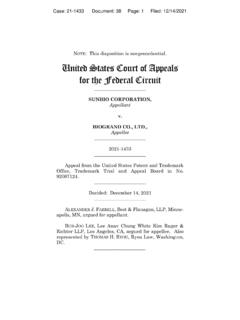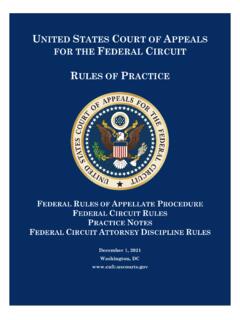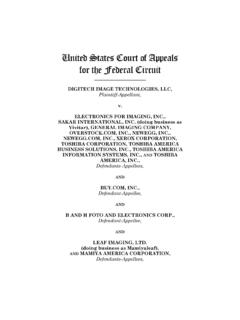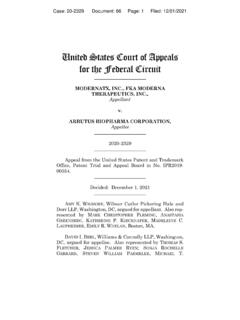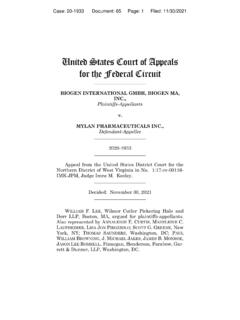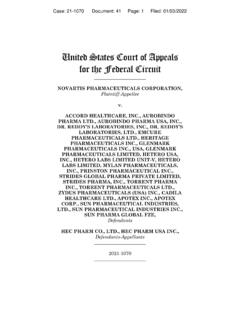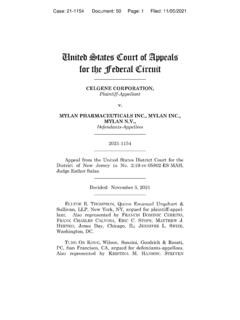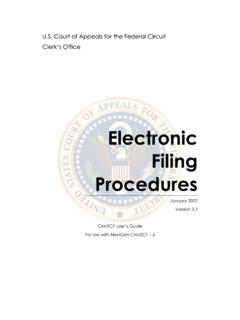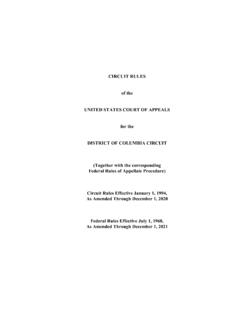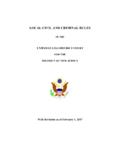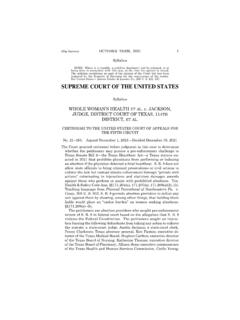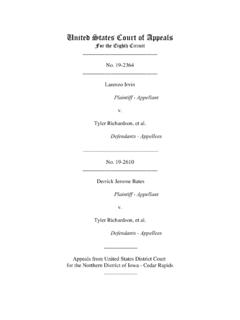Transcription of N United States Court of Appeals for the Federal Circuit
1 NOTE: This disposition is nonprecedential. United States Court of Appeals for the Federal Circuit _____ QUEST DIAGNOSTICS INVESTMENTS LLC, Appellant v. ANDREW HIRSHFELD, PERFORMING THE FUNCTIONS AND DUTIES OF THE UNDER SECRETARY OF COMMERCE FOR INTELLECTUAL PROPERTY AND DIRECTOR OF THE United States PATENT AND TRADEMARK OFFICE, Intervenor _____ 2021-1115 _____ appeal from the United States Patent and Trademark Office, Patent Trial and appeal Board in No. IPR2019-00738. _____ Decided: December 27, 2021 _____ THOMAS H. WINTNER, Mintz, Levin, Cohn, Ferris, Glov-sky and Popeo, , Boston, MA, for appellant. Also rep-resented by PETER CUOMO; ADAM GAHTAN, Fenwick & West LLP, New York, NY. Case: 21-1115 Document: 58 Page: 1 Filed: 12/27/2021 QUEST DIAGNOSTICS INVESTMENTS LLC v. HIRSHFELD 2 ROBERT MCBRIDE, Office of the Solicitor, United States Patent and Trademark Office, Alexandria, VA, for interve-nor.
2 Also represented by THOMAS W. KRAUSE, FARHEENA YASMEEN RASHEED, MEREDITH HOPE SCHOENFELD. _____ Before MOORE, Chief Judge, CLEVENGER and CHEN, Circuit Judges. CHEN, Circuit Judge. Quest Diagnostics Investments LLC (Quest) Appeals a decision of the Patent Trial and appeal Board (Board) in IPR2019-00738 finding claims 1, 2, and 4 14 of Patent No. 8,409,862 (the 862 patent) unpatentable as either an-ticipated under 35 102 or obvious under 35 103. For the reasons stated herein, we affirm. BACKGROUND Quest owns the 862 patent, which claims priority to September 8, 2003 and is directed to using mass spectrom-etry to detect low levels of testosterone in female humans. See, , 862 patent col. 1 ll. 49 59, col. 5 ll. 50 65, claim 1. The 862 patent explains that [t]estosterone levels are much lower in females compared to males and [t]he clin-ical manifestations of excess testosterone in females in-clude infertility, hirsutism, amenorrhea, and obesity.
3 Id. col. 1 ll. 49 59. The 862 patent further explains that tes-tosterone can be purified prior to mass spectrometry, which can improve the limit of detection ( , the lowest amount of testosterone the method can detect). See, , id. col. 3 ll. 7 21. Accordingly, the 862 patent claims methods for determining the amount of testosterone in a sample where a user purifies the testosterone prior to mass spec-trometry. Id. at claim 1. However, the 862 patent explic-itly excludes derivatization of testosterone before mass Case: 21-1115 Document: 58 Page: 2 Filed: 12/27/2021 QUEST DIAGNOSTICS INVESTMENTS LLC v. HIRSHFELD 3 spectrometry, the lack of which Quest argues offers im-provements in ease of See id. Claims 8 and 9, relevant here, depend upon claim 1 and further require wherein the method is capable of detecting testosterone at concentrations of less than 5 ng/dL in the sample and less than 1 ng/dL in the sample, respec-tively.
4 Id. at claims 8 9. On February 25, 2019, Laboratory Corporation of America Holdings (LabCorp) petitioned for inter partes re-view of claims 1, 2, and 4 14 of the 862 patent. 79, 152. Relevant to this appeal , LabCorp asserted that claims 8 and 9 would have been obvious in view of Clarke,2 or al-ternatively would have been obvious in view of Clarke in combination with Clarke is an abstract found on a compact disc (CD) from the 49th annual conference of the American Society for Mass Spectrometry (ASMS) held in May 2001. 1356 57. Clarke details a method for detecting low levels of tes-tosterone and describes a method similar to the 862 pa-tent wherein testosterone is purified before mass spectrometry. Lab y Corp. of Am. Holdings v. Quest 1 Quest explains that derivatization of testosterone is one method to improve detection of testosterone using mass spectrometry.
5 See Appellant s Br. at 6 7. However, Quest contends that the derivatization process can be labo-rious and time consuming. See id. 2 Clarke, et al., Determination of Suppressed Testos-terone Levels in Human Serum by LC-MS/MS, Proceed-ings of the 49th ASMS Conference on Mass Spectrometry and Allied Topics, Chicago, Illinois, May 27 31, 2001. 3 Draisci, et al., Quantitation of anabolic hormones and their metabolites in bovine serum and urine by liquid chromatography-tandem mass spectrometry, 870 J. CHROMATOGRAPHY A, 511 22 (2000). Case: 21-1115 Document: 58 Page: 3 Filed: 12/27/2021 QUEST DIAGNOSTICS INVESTMENTS LLC v. HIRSHFELD 4 Diagnostics Invs. LLC, 2020 WL 5224211, at *6 7 ( Sept. 1, 2020). Clarke claims to detect testosterone down to 50 pg/mL equivalent to 5 ng/dL. C On September 1, 2020, the Board issued its Final Writ-ten Decision finding that claims 1, 2, and 4 14 would have been unpatentable as either obvious or anticipated.
6 See id. at *1. Two of the Board s findings are challenged here fir st, that Clarke was valid prior art as a printed publica-tion and, second, that claims 8 and 9 would have been ob-vious in light of Clarke or Clarke in combination with Draisci. As to whether Clarke is a printed publication, the Board found Clarke was publicly available and therefore a prior art printed publication. Specifically, the Board rec-ognized that the ASMS sent a CD containing Clarke to thousands of ASMS members, and that the CD was avail-able in the University of Wisconsin-Madison library before the priority date of the 862 patent. See id. at *8 10. Fur-ther, the Board noted that although Clarke appeared alongside approximately 1,600 other abstracts, the CD per-mitted users to search the abstracts using selected key-words.
7 See id. at *10. Given the dissemination, accessibility, and searchability of the CD, the Board found Clarke to be prior art. Id. As to claims 8 and 9, the Board concluded it would have been obvious to reach detection limits below 5 ng/dL and 1 ng/dL based on the teachings of Clarke or Clarke with Draisci. The Board found that a skilled artisan would have been motivated to achieve a lower level of detection and have reached these levels by optimizing several experi-mental parameters, specifically by increasing the volume of the sample and modernizing the equipment. Id. at *19 20. Case: 21-1115 Document: 58 Page: 4 Filed: 12/27/2021 QUEST DIAGNOSTICS INVESTMENTS LLC v. HIRSHFELD 5 DISCUSSION On appeal , Quest makes two First, that the Board erred in finding Clarke was publicly available and thus the Board s unpatentability determination as to all challenged claims must be reversed.
8 Second, that the Board erred in holding that claims 8 and 9 would have been obvious over Clarke and/or Clarke in view of Draisci. We address each in turn. A Quest argues that Clarke was not a printed publication because it was not publicly accessible. See Appellant s Br. at 40 55. Whether a reference qualifies as a printed pub-lication .. is a legal conclusion based on underlying fac-tual findings. Jazz Pharms., Inc. v. Amneal Pharms., LLC, 895 1347, 1356 (Fed. Cir. 2018). We review the Board s legal determinations de novo and the underlying factual findings for substantial evidence. Id. at 1355. The Board found that the ASMS widely disseminated the CD containing Clarke and that the CD was available in a university library. See Lab y, 2020 WL 5224211, at *7 10. Quest largely ignores the ASMS s public dissemination and instead highlights that Clarke was a single abstract out of approximately 1,600, all with minimal indexing.
9 See Appellant s Br. at 43 45. Quest contends that this makes Clarke an obscure, inaccessible reference. We disagree. As this Court has recognized, the breadth of the dis-semination [] to persons of ordinary skill is significant, and [w]hether the disseminated material is addressed to 4 Initially, Quest also argued for reversal on the ba-sis of unconstitutionality of inter partes review under the Appointments Clause. See Appellant s Br. at 56 57. How-ever, Quest has since abandoned this argument. See ECF No. 30. Case: 21-1115 Document: 58 Page: 5 Filed: 12/27/2021 QUEST DIAGNOSTICS INVESTMENTS LLC v. HIRSHFELD 6 or of interest to persons of ordinary skill is also relevant to the public accessibility inquiry. Jazz Pharms., 895 at 1357 58. Here, although Clarke was surrounded by hundreds of other abstracts, the ASMS distributed the CD to the specific people most motivated to search the CD and find Clarke, a fact Quest does not dispute.
10 Moreover, the CD permitted keyword searching. While the CD did not allow users to search the word testos-terone, the CD permitted several mass spectrometry-re-lated keywords. Lab y, 2020 WL 5224211, at *10; see also 1347 55 (listing search terms). Quest objects that LabCorp did not identify the specific keywords the Board ultimately relied on and presented no evidence that such keywords could meaningfully narrow the abstracts. Appel-lant s Br. at 48 54. Nonetheless, given the wide dissemi-nation of the CD, we are unpersuaded that any identified limitations in searchability require finding Clarke inacces-sible. As this Court has already held, a printed publication need not be easily searchable after publication if it was suf-ficiently disseminated at the time of its publication. Suf-folk Techs., LLC v.
